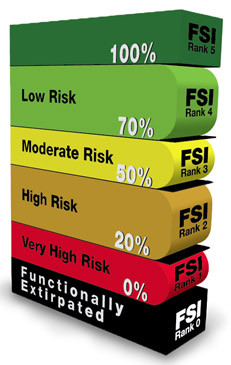Non-urgent government operations are closed December 24 to January 1, reopening January 2. View available services during this period.
Fish Sustainability Index (FSI) overview
The FSI is Alberta Fish and Wildlife's method of assessing fish stocks on a provincial scale.
Alberta is experiencing rapid growth and environmental change. Fisheries managers must understand the 'big picture' of how present conditions and future threats will affect fish.
The FSI was developed to bring consistency to individual fish stock assessments and provide a province-wide evaluation of the status and sustainability of Alberta fish species.
- A Generic Rule Set for Applying the Alberta Fish Sustainability Index – Second Edition
- Limitations and Caveats of Alberta's Fish Sustainability Index (FSI)
FSI: How it's done
We use data and information from a variety of sources, including:
- fisheries surveys
- scientific literature
- local and traditional knowledge
- expert opinion
Seventeen different metrics are summarized and integrated to classify:
- population integrity
- the productive potential of the habitat
- threats and their mitigation
We also evaluate the reliability of the data used to score each metric based on the amount of data/information, the age of the data and its consistency.
Together, these metrics provide a description of the current status of a fish population, their habitat and the threats they face.

Scoring the metrics
Each metric is scored on a scale from 0 to 5.
- 0 is a fish population has already disappeared or one that is no longer sustainable
- 1 is a population that is least sustainable
- 5 is the most sustainable population
For the majority of FSI metrics, these rankings are easily translated into an evaluation of risk, where a FSI score of 1 is a population at very high risk, and a rank of 4 and 5 represent a population at low risk.
For more details, see:
Uses of FSI results
The results of the FSI can be used to support the following actions:
- Allow for broad comparisons to changes in fish species sustainability over time.
- Allow for comparisons between fish sustainability and management actions.
- Direct effective future recovery and management actions.
- Educate decision-makers, conservation partners, private industry and the public on the status and risk of fish species compared to historical levels, how the condition of surrounding watershed is influencing fish population health, and threats that may jeopardize population persistence.
- Provide information to assist in the development of specific watershed restoration plans and integrated watershed strategies.